Information about how to mix brown color from basic colors, can be useful in the process of decoration or design work, in the process of finishing or for artistic purposes. A complex brown is obtained by combining 3 types of basic colors at once. Then other colors are added to lighten or darken the tone, add saturation or make the shade pastel and soft.
Characteristics and shades
In psychology, the color is associated with stability, labor on the land, everyday knowledge and wisdom. People associate this color with natural elements, land and agriculture. At the same time, the color also evokes a number of negative emotions associated with the processes of fading, aging and poverty.
Color has a neutral effect on the human psyche, it relaxes rather than irritates, since a person sees this color and its shades in everything that surrounds him every day. Therefore, color is often used to bring a person to a state of balance, peace and harmony.
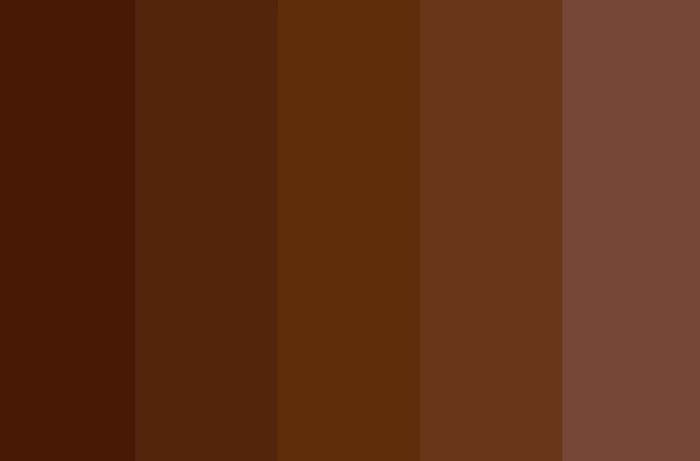
People who prefer brown shades are most often caring, love routine, they value traditions and foundations, work for the benefit of their family. They understand a simple way of life. They love nature and a natural style in home decoration. These are respectable people who value practicality and are not used to rushing.
In the artistic community, brown is called complex because it is obtained not from 2 primary colors, but from 3 colors - yellow, red and blue are mixed in equal proportions. Sometimes, instead of one primary color, its derivative is used. To make the tone more complex, a secondary color is added so that the brown is richer or softer.
There are 8 types of brown, which differ in color undertone:
- brownish yellow;
- brown-gold;
- medium brown;
- grey-brown;
- black-brown;
- red-brown;
- brown with a red undertone;
- bright brown.
Mixing rules
There are many different ways to mix brown, and there are more of them than with other colors, because in the process, you can use a large number of additional colors without losing the main tone:
- yellow;
- blue;
- red;
- white;
- black.
It is easy to obtain new shades by mixing paints, since brown reacts well to new components, and the human eye easily recognizes many shades of this color.
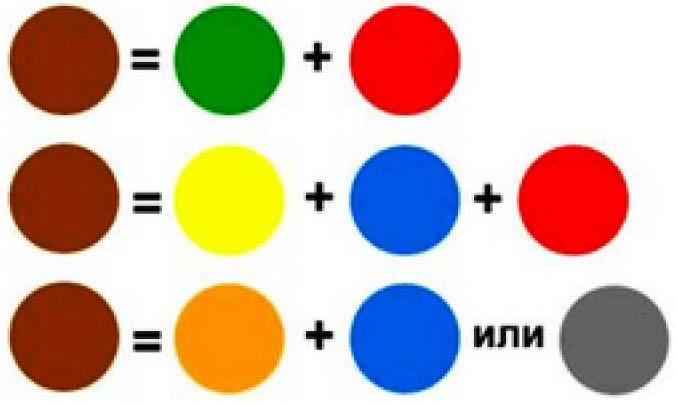
You can mix brown color using different combination formulas:
- Mix green with red dye. Try not to use dark versions of the original paints, otherwise the shade of brown becomes close to black.
- Combine yellow, red and blue colors. The method is similar to the previous one, since green consists of blue and yellow. This formula is convenient to use if the palette runs out of green paint. When combining 3 or more colors, the finished mixture loses saturation.
- Combine orange with gray or black. Blue is more often found as a ready-made dye in a ready-made palette, so the combination with it is more common.
- Mix violet with yellow. This method is less popular because of the difficulty of maintaining the proportion. If it is violated, the shade changes greatly.
The process of mixing paints to obtain brown involves a number of rules.
- To mix a certain shade of paint, precise proportions are observed.
- You can control the change in tone during mixing. To do this, add additional paints gradually and little by little, otherwise the mixture will turn out dirty.
- When the shade is ready, it is first tested on the surface to be painted. The color may change on different surfaces or after drying.
- Some types of paint can be mixed directly on the work surface. In these cases, it is also recommended to make test strokes to ensure that the mixed shade is correct.
- Darken the brown by adding black paint.
- Make brown brighter by adding red paint.
- Lighten brown or make its tone warmer by adding yellow.
- Another way to lighten brown is to add whiteness. Try to dilute the mixture with a small amount of white, otherwise the mixture will turn out dirty and cold.
From the primary colors
Mixing brown may be required for artistic purposes, during construction, in finishing or other works. The process of mixing paints to obtain brown shades is resorted to when the basic palette of this dye is not enough.
Before you start mixing paints, figure out which primary and secondary colors you can use to make brown.
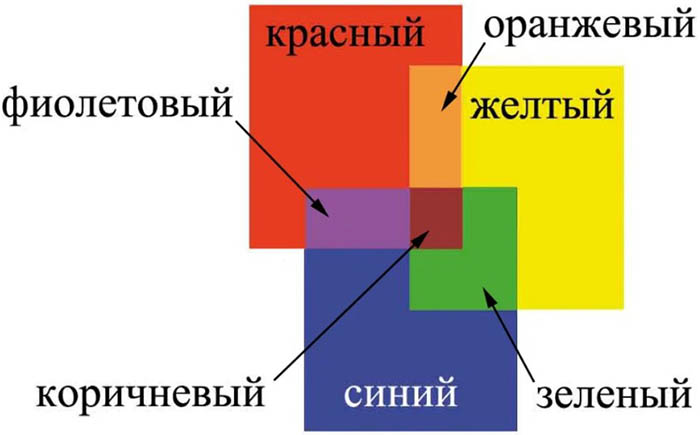
The simplest and most common way to make brown from other colors is to mix 3 basic colors. These are colors that cannot be obtained by mixing other colors - blue, red and yellow. The proportions are different - add all the colors in equal quantities or emphasize one or two dyes.
Once the brown is ready, a secondary color (a color obtained by mixing primary colors) can be mixed into it to change the shade.
Classical
If you don't have brown in your paint palette or you've run out of it, you can get it by mixing:
- basic colors;
- purple (red with blue) with yellow;
- green (yellow with blue) and red.
Medium brown
Medium shades of brown are slightly lighter than the classic ones, they are more common in nature, this color may be needed for artistic or decorative purposes.
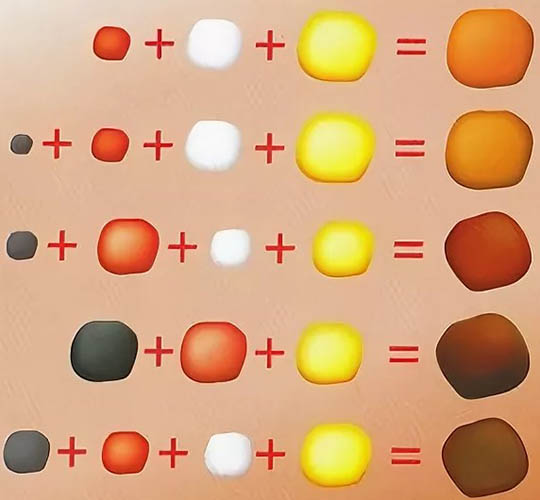
Mid tones are obtained by mixing:
- red and yellow in a ratio of 1:1, diluted with 0.5 parts blue;
- a little yellow is mixed into the brown;
- a little red is added to brown.
Red-brown
Brown shades with a red undertone are obtained by mixing:
- emerald with red;
- medium green with red;
- 2 parts red and yellow and 0.5 parts blue;
- Add a drop of yellow and red to the brown one, one after the other.
Brown-gray
To get brown with a gray undertone, mix:
- brown and a drop of black and white alternately until the desired shade is obtained;
- yellow and red, then blue;
- yellow and red, then blue.
Dark brown
Brown is made darker by adding a drop of blue or black dye. The finished mixtures made in this way do not differ much in saturation.
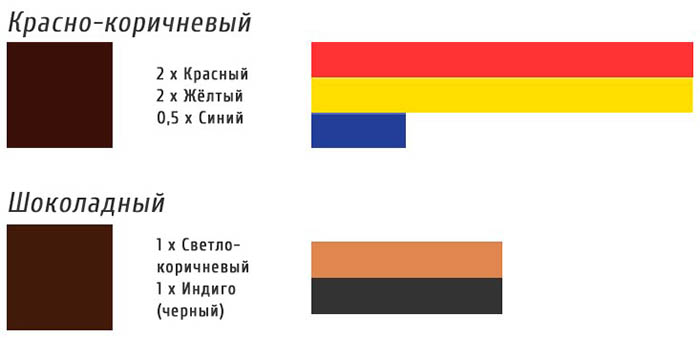
The dark pigment is added in small drops so as not to spoil the shade. Each time the mixture is thoroughly mixed so that there are no streaks or inclusions.
Light brown
Brown is made lighter by adding:
- white – add carefully to avoid a grey undertone;
- yellow;
- red – add in small doses, excess can darken the shade.
From different types of paints
There are different ways to mix brown, which differ depending on the type of paint, because each has its own characteristics in the process of mixing, dilution and application. Liquid or watery dyes mix faster, they are often mixed directly on the work surface, but this is not always convenient due to the speed of drying.
Paints can also change their shade or saturation after drying. The texture and thickness of the coloring substance should also be taken into account during the mixing process, which may differ in time or the technique of combining the paints.
Gouache
Gouache is rich and dries quickly. This paint is suitable for drawing or other types of creativity. You can find a ready-made palette of brown shades in stores.
Despite the wide range of shades of brown in ready-made dyes, in some cases they are not enough and resort to the mixing process.
Examples of combining paints are given above, but it is worth considering the structure of the dye, which affects the final color.
- Prepare paints, brushes, a palette for mixing or another surface, a container for water. It is advisable to mix gouache on a white surface to track the shade without optical changes.
- Before mixing, dip the brushes in water and then in paint. Combine the necessary paints, adding a new color little by little. Try not to mix more than 3 paints at a time, otherwise the finished color may have a dirty undertone.
- Lighten the mixture with white dye. It gives a cold shade. Water-soluble paint can be lightened by 1-2 tones with water, but then the mixture will lose its saturation.
- You can darken the mixture by adding black. It has a strong effect on the mixture, so add black carefully, in small drops.
- Make a test stroke on paper or another surface and wait for it to dry. After the gouache has dried, the color may change. If necessary, add more paint to the mixture and make another test stroke.
- Once the desired shade is obtained, painting begins.
Acrylic paints
Acrylic paints as a universal dye are used by artists, designers, etc. This dye in its pure form looks bright and saturated. Acrylic paints are sold in stores individually or in ready-made sets, but brown is not always found in them.
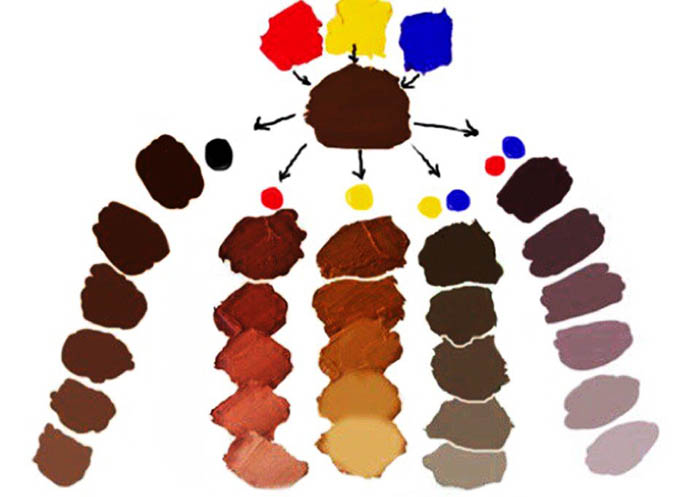
Therefore, they resort to mixing primary colors.
- A small amount of blue, yellow and red paint is applied to the palette in equal quantities. The dyes are thoroughly mixed to obtain a brown color.
- Additional paints are added in small portions to achieve the desired shade. Ready-made proportions for acrylic paints are difficult to calculate due to the texture of the dye, so the desired tone is achieved by manual mixing.
| Additional color | Effect |
| White | Lightens the tone. Excess can make the tone cold. |
| Black | Darkens the tone. Too much can make the tone look muddy. |
| Black and yellow alternately | Greenish-brown undertone. |
| Red with black, then with yellow | Chestnut |
| Red with black, then white | Reddish-brown |
| White with yellow, then brown | Golden |
| Yellow with white, then brown | Beige |
| Black, red and yellow | Dark brown |
- Adjust the saturation and brightness of the color by adding black and white dye.
- Make a test stroke on paper or another surface. Wait for it to dry to compare the tone of the mixture and the dried stroke. Acrylic tends to change color saturation after drying.
- If necessary, adjust the mixture again and take a test smear.
- Once the desired tone has been achieved, painting begins.
Watercolor
To obtain the desired brown color, artists are advised to use watercolors because of the ease of working with this type of paint. Watercolors are easy to mix and make adjustments. Ready-made shades of brown are sold in tubes or briquettes individually or in sets.
If the ready palette does not have the necessary shade of brown or there is no way to find the necessary shade, it can be composed from the basic watercolor colors.
To do this, follow the algorithm.
- Prepare the tools needed for the work: a white palette or other container for mixing paints, a container with water, brushes, yellow, red, blue paints and auxiliary colors. Watercolors are mixed only on a white surface so that it is possible to track the color change. This can be a palette, dishes or a sheet of paper.
- Red, yellow and blue are combined in the right proportion, which may determine the finished shade. The dye that should predominate in the tone is used to a greater extent. The secondary dye is introduced gradually, each time thoroughly mixing the paints and washing the brush.
- If necessary, additional colors are introduced to give the desired undertone. Black is used to darken the shade, white - to lighten. Watercolor is also lightened with water.
- When the desired tone is achieved, a test stroke is made on a rough sheet and waited for to dry. If the color has changed, additional paints are added to the mixture and a test stroke is made again.
- Once the desired color is obtained, painting begins.
Pencils
Mixing brown with pencils may be necessary if you don't have the right dye. To achieve different shades of brown, artists use the hatching method, layering one color on top of another.
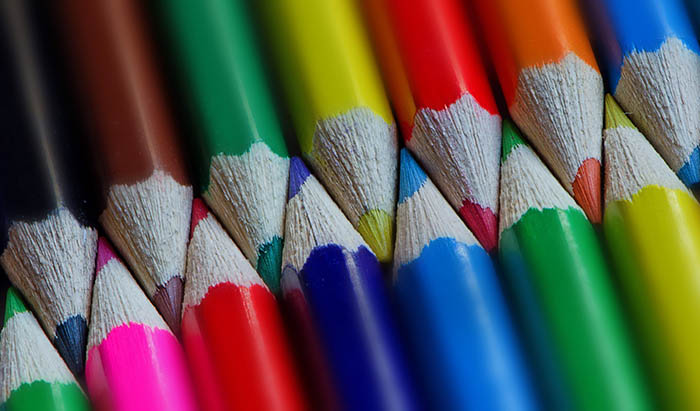
The strokes are made with a slight pressure to be able to regulate the color saturation. At the end of the process, when the desired tone is obtained, shading is done or the tone is smoothed with an eraser.
Brown shades are achieved by shading, using the following methods:
- Apply alternate strokes of green, orange and violet. The tone of each primary color affects the final shade.
- The red-brown shade is obtained by shading with a red, then yellow and a little purple pencil.
- The light brown shade is obtained by shading with a yellow, then red and a little blue pencil.
- The chestnut shade is obtained by shading with red and scarlet pencil. A little yellow, lemon, blue and light blue are added on top.
- Golden brown is obtained by shading yellow and lemon. A little red, scarlet, blue and light blue pencils are applied on top.
- The dark brown shade is obtained by shading blue and light blue. A little red, scarlet, yellow and lemon are added on top.
- The effect of color transition and its volumetric overlay is created by shading. To do this, paint the main area. Darker and lighter tones are applied to the dark areas. The remaining areas are left dim.
Pros and cons of mixing yourself
| Benefits of Mixing Paints | Benefits of using ready-made dye |
|
|
Information on how to mix brown may be necessary in the absence of a ready-made dye in various areas of application. But the process of mixing paints may not always be more profitable and successful than using a ready-made tone.
Video about color mixing
How to mix any brown shade:
